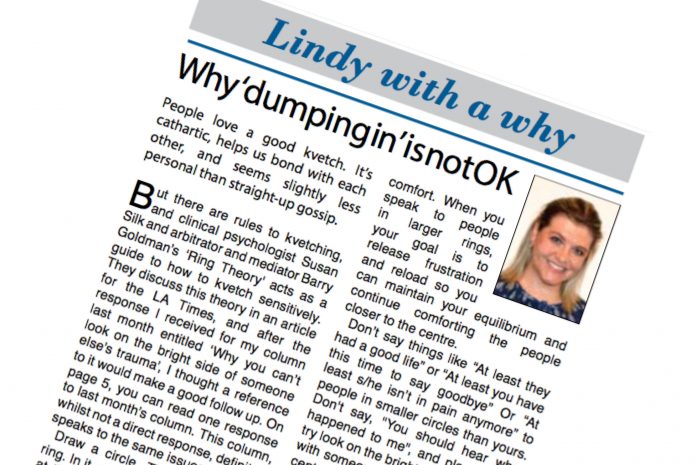People love a good kvetch. It’s cathartic, helps us bond with each other, and seems slightly less personal than straight-up gossip.
But there are rules to kvetching, and clinical psychologist Susan Silk and arbitrator and mediator Barry Goldman’s ‘Ring Theory’ acts as a guide to how to kvetch sensitively. They discuss this theory in an article for the LA Times, and after the response I received for my column last month entitled ‘Why you can’t look on the bright side of someone else’s trauma’, I thought a reference to it would make a good follow up. On page 5, you can read one response to last month’s column. This column, whilst not a direct response, definitely speaks to the same issues.
Draw a circle. This is the middle ring. In it, put the name of the person at the centre of the trauma. This is the main person experiencing the trauma.
Now draw a larger circle around the first. This ring contains the people closest to the person in the centre. Then draw concentric circles, repeated until you have created all the rings you need to include all the people who could be involved in some way. Prioritise closest family and friends, with colleagues and acquaintances in the outer rings.
You now have a recipe for kvetching sensitively.
The person in the centre ring can say anything they want to at any time to anyone else in any of the circles. This person can moan and be needy, they can be angry and defensive. This is the one benefit of being in the centre ring.
Everyone else in the circles can do this too. But only to people in larger rings than theirs. When you start to kvetch to someone in a smaller ring, you are failing at kvetching sensitively. When you talk to people closer to the trauma, your goal is to comfort. When you speak to people in larger rings, your goal is to release frustration and reload so you can maintain your equilibrium and continue comforting the people closer to the centre.
Don’t say things like “At least they had a good life” or “At least you have this time to say goodbye” Or “At least s/he isn’t in pain anymore” to people in smaller circles than yours. Don’t say, “You should hear what happened to me”, and please don’t try look on the bright side of a trauma with someone in a ring closer to the centre than you. Just don’t. But you can do all these things to people in larger circles than yours.
The idea is ‘comfort inwards’ and ‘dump outwards’.
Most of us intuitively understand this theory. The authors of ‘Ring Theory’ explain that we wouldn’t comment to a cancer patient about how gaunt she is looking. Almost no one would say that looking at her makes them think of the fragility of life and their own closeness to death. In other words, we know enough not to dump into the centre ring. ‘Ring Theory’ merely expands intuition and makes it more concrete: Don’t just avoid dumping into the centre ring, avoid dumping into any ring smaller than your own. Remember, you can say whatever you want if you just wait until you’re talking to someone in a larger ring than yours. Which is what makes Twitter commentary so problematic. There are no rings. There is just open space.
The next time someone ‘overreacts’ to something you think is perfectly within your right to say, try use ‘Ring Theory’ to establish where they sit in relation to you in the circles on the topic.
I have been practising this using individuals and groups in the centre and found the results illuminating.











